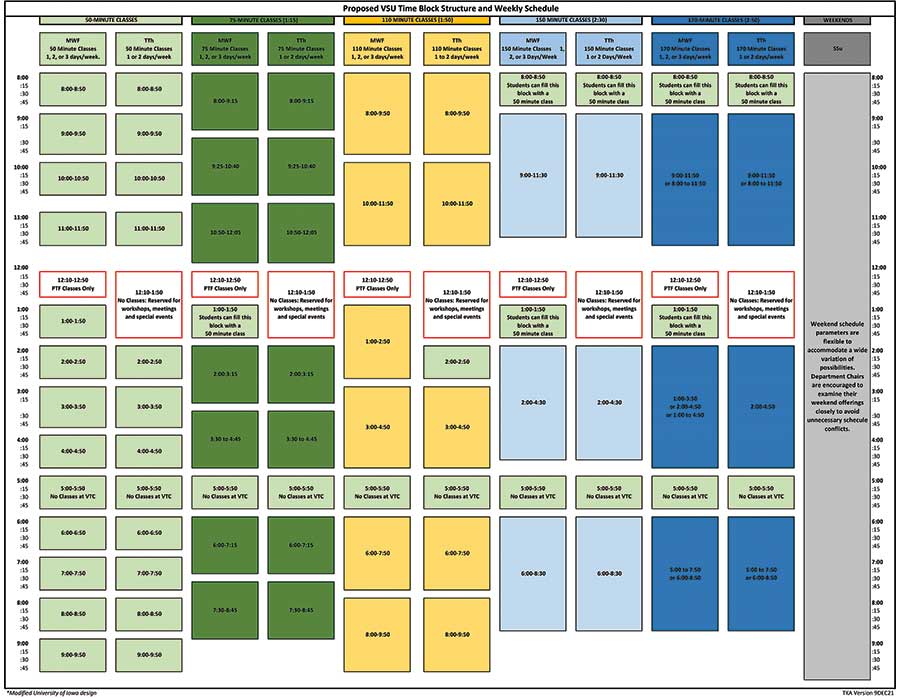Uniform class scheduling across four campuses to begin in fall 2022
As a part of the transformation of the Vermont State Colleges system into Vermont State University, all campuses will be shifting to a uniform time block for classes. Previously, each campus has operated within its own schedules, causing scheduling conflicts for faculty and students trying to work across campuses. This scheduling change is one of many efforts to eliminate conflicts across the campuses.
“The way it is right now, our schedules don’t match up,” says Preston Garcia, chair of Castleton Faculty Assembly. “And one of the things that we’ve noticed big time is that we can’t find a common meeting time because our class schedules are so different.”
NVU-Johnson Faculty Assembly chair Professor of Behavioral Sciences Janet Bennion concurs, noting that faculty have struggled to work with their opposing schedules, and students have had to jump through hoops to get their classes to line up across campuses.
“They have tried to deal with the Herculean task to make sure all of the four campuses are able to have the upmost flexibility,” Bennion said. “This is one of the perils of combining four different campuses that have grown comfortable with their ways.”
On NVU’s side, the earliest class start times will move to 8:00 a.m, which will not impact Castleton, since their starting classes already align with the new schedule. “We have 8:00 a.m. classes and NVU does not,” Garcia said. “I believe that 8:00 a.m. stayed only because if we started at 8:30, from the Castleton perspective, we don’t have enough time in the day to push that forward.”
The earlier start does not appeal to all NVU students or faculty, though. “Many people, students included, may not favor going to school at 8:00 in the morning,” says Bennion, “but some people like it. And so, it provides a lot of choice and flexibility.”
If someone’s personal schedule does not align with an earlier start to the day, they have the choice to take later classes in most cases.
At second glance, faculty have realized that this change is not as horrendous as previously expected. “Once you study the flexibility inherent in the system, which was really crafted very well by [Associate Academic Dean] Thom Anderson, you’ll notice that faculty can choose not to teach on Friday, “says Bennion. “They can choose to actually meet with their students in a way that’s not too early, and maybe even use technologies such as Zoom to accommodate some of these things.”
Since working from home has become more accessible, Bennion has been saving herself an hour drive on Fridays by working from home, and this schedule shift does not necessarily mean she has to change that.
“Even before the merger, this probably should have happened,” says Garcia, who is very much on board with the new cohesive time blocks. “We were always under the same umbrella, the Vermont State Colleges. I don’t know whose schedule came first or whose changed, but it’s just interesting that they are so different.”
Bennion noted that in this transformation process, creative compromise is key. “No wonder Castleton likes the new schedule,” she said. “It’s their schedule, basically…but there are other things that we have asked Castleton to do that were not as easy as they were for us. So, you have to try to find what’s best for the greater good.”
The process of combining with another entity involves a lot of push and pull, and no one campus will be completely satisfied with every decision made along the way. “Even though it’s not exactly what we’re used to, we can stretch ourselves to accommodate the needs of other faculty at other campuses,” says Bennion.
The new schedule will be incorporating what Castleton calls an “N” period. “There’re no classes from 12:30 to 2:00, every Tuesday/Thursday, and that sets meeting dates for us, students can have club meetings,” Garcia said. “You’re guaranteed that no one has class at that time.”
While the exact dates and times of this “N” period will be shifting in the new schedule, university faculty will be able to use this time block to hold cross-campus meetings.
Another feature of the new scheduling will be a uniform meeting time for all first-year seminars, which at NVU have typically been offered at various times throughout the week. Beginning in fall of 2022, all first-year seminars will be scheduled on Tuesdays and Thursdays from 10:50 to 12:05.
“From a logistical and advising sense, this makes a lot of sense, especially for students,” Professor of Writing and Literature and coordinator of the first-year seminars Tyrone Shaw said. For example, if a student in the first couple of weeks decides they’d rather be in a different seminar and there’s room, they can easily shift without any disruption to their schedules.”
The new scheduling changes will begin fall 2022, one year before the official change to Vermont State University.
“It should start as soon as possible,” says Garcia, “simply because we’re already trying to make classes available to students across the system.”
With the new cohesive time blocks, students will be able to take classes at multiple campuses without any awkward overlaps.
“We have to actually begin this rapid adaptability mentally, emotionally, and change our habits very quickly,” says Bennion. “So that means definitely changing habits, changing schedules, and what you’re used to doing may not be exactly the same.”
Professors are already beginning to turn in their new schedules for fall 2022 across the campuses.
Overall, response to this change seems to be optimistic. While it may take some adjusting, especially for faculty who have had the same routine for years, it is generally recognized that this shift will allow the most flexibility for the greater population of the new university.

First year student from Orlando, FL.
Working on her second bachelors.
Love poetry, anime, and her dog (mostly her dog).
Dreams of living in a van.



